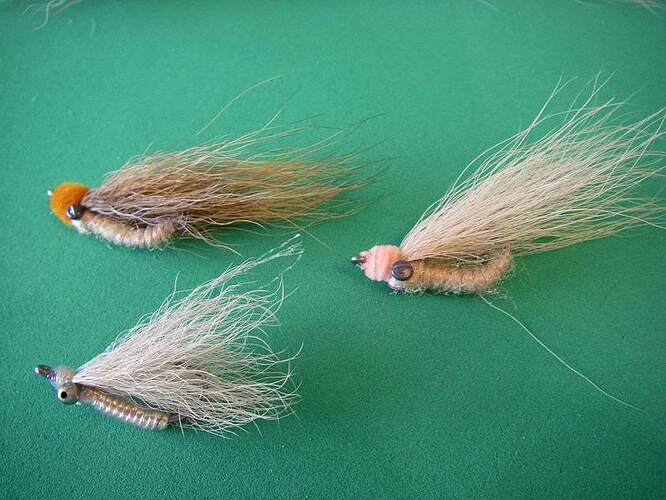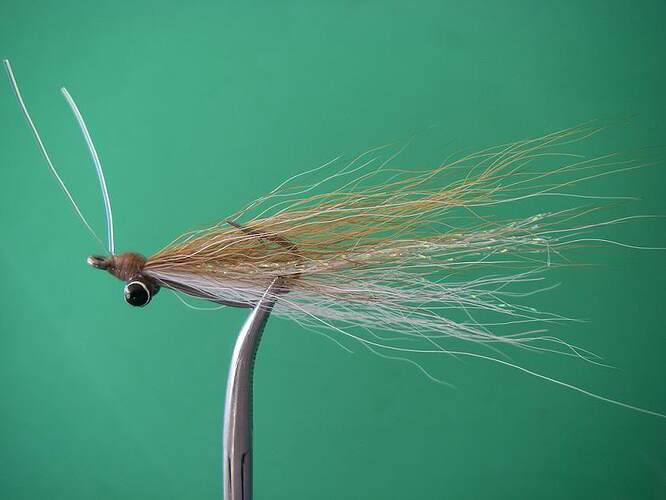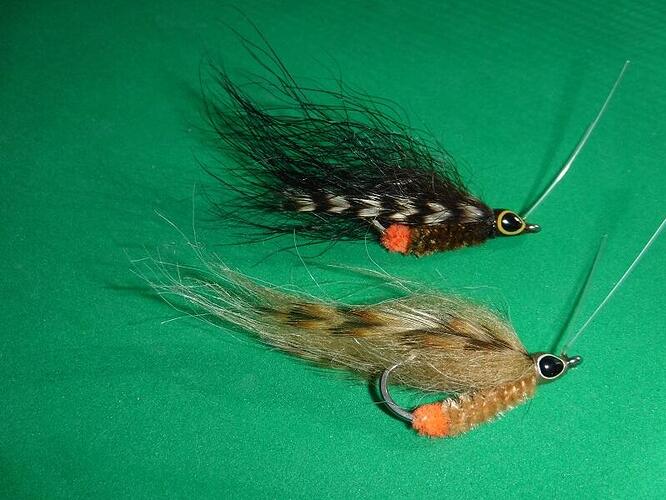Zero specific experience input to offer, but I can say the difference in my 6wt dropping a a bead chain shrimp, vs my 8wt is huge. If it were me, going purely off your description, I think I’d go with the 6wt, weed guarded light fly, and try to get a little more distance between you and the fish. Maybe open your loops up a bit so the fly the lands a little easier. Sometimes the tight loops can put a lot of energy into the landing. I like to practice by throwing at mullet. Figure if I can land a fly near them spooky SOBs any other fish outta be a walk in the park..lol..
Would love to see it thanks!
Right now not worrying about opening hooks. Most of these fish (with the exception of one I saw) are a few pounds not bruisers. For now want to JL focus on just feeding them but thanks I’ll look into alternative patterns I do have some of the hooks you mentioned in the appropriate sizes. Appreciate the input👍
Funny you mention that I was trying to open my loops to land softer only issue I was having is I’m having trouble getting enough energy in the loop to get it to land where I want it usually kicks off in the breeze. At this point for me to be accurate I need that tight loop with good energy but it doesn’t land as soft. When I open the loop I lose that control but it does land lighter. Just another nuance in the game I need to develop. Haven’t dusted off the 6 in a while, will bring it with me next time for sure.
Haven’t waded for tailers in years - but here’s how I did it - with success on fish up to nearly ten pounds (Nearly fifty years ago an 8lb fish was the average for Biscayne and nearby areas. I chose the ocean side since the bottom is much firmer than the bayside, and we used an 8 or 9wt rod with a roughly ten to twelve foot leader - ending in three feet of 10lb Ande clear mono (no fluoro back then -it hadn’t been invented…).
Wading for tailers is the only way to go - but with seriously spooky fish you need to make your presentation everything. I learned to use a “gambling style” presentation laying that fly out as much as ten feet in front of the fish. I call it gambling since bones rarely move in a straight line and half the time your fly isn’t where you want it to be. The trick is to note exactly where your fly landed - and not move it at all. If the fish isn’t coming to it, pick it up and lay out another cast, hopefully where it will be intercepted -but never near a fish since they’re just too spooky… When you know where your fly is wait until the fish it almost on top of it - then give it a single twitch- hardly moving it at all. Many times the fish will react and pick it up and you’re in business. Other times you’ll repeat and repeat - if no strike allow the fish to move away, pick up your fly and try again. Usually your best shot is when that fish first sees the fly. By the way many forget that bones can see you if you’re not careful… Lowering your profile by crouching down and easy sidearm casts to keep your fly line out of sight will all aid in fish not seeing (or hearing you at all…). In murky waters (or where fish are actively mudding…) none of these precautions are necessary but in calm winds and clear waters I always tried to be as invisible as possible…
Now for the flies.. over grass you need either a weedguard or a fly that’s naturally weedless. Here’s a few bugs we used with success all those years ago - every one on a #4 Mustad 34007 hook…
If you don’t move these bugs they will rest on top of the grass - most of the time - then you only twitch once or twice hoping for a reaction strike… If you try a normal retrieve they’ll snag up eventually. Flies with bead chain eyes scare tailing bones when they land close by - ten feet away, they’re hardly noticed…
if needed, these can be tied up - with no eyes at all… for a very soft presentation…
this “bonefish clouser” was always a staple over grass since the outrigger style weedguard allows you to sink it into grass then retrieve it without snagging at all… Every shop I tied for wanted these in every color imaginable - in both #4 and #6 sizes..
Here’s my version of Chico’s Snapping shrimp in two colors - another great old pattern for grass bottoms. I always preferred black bear hair for the wings (the light colored one is in the cinnamon phase black bear…).
Great post Capt. Bob!
This.
It is a debated topic, but results IMO show that opening up the loop allows the line to fall quietly to the water. The debate is some say they can control the line with a tight loop and make it land quietly. Stored energy is stored energy - physics wins every time. I use way less energy on my forward cast than on my back cast to help make the line land softer.
One way to envision this is that think of the tight loop traveling forward and hitting the water - the stored energy in the line is meeting resistance on the top of the water - the line makes a shearing affect if the line is still traveling forward, which in return makes sound waves in water. Not just from one point, but from linear feet of line.
This is similar to throwing a pebble into a pond - it makes ripples. Line landing on water does the same thing, but with pressure waves the fish can sense.
I had a guide tell me once that even my line in the air was traveling way too fast - slicing through the air and the fish could sense it. Seriously. He told me to slow it down and open my loop up. Years later another guide showed me his approach - large open loops that land quietly. Both were permit guides and swore that lighter, more open loops resulted in more fish.
Sound travels 4x faster in water than air, but also it travels farther. A sound that can be heard from 50 feet above ground can be heard or felt 250 feet away in water.
Thanks Bob. Love the flies. The first pic UL is almost exactly like the “unweighted” fly I tried. I also have a couple of those snapping shrimp I bought maybe 30 years ago.
Thanks for the recommendation and inspiration to fill out my bonefish box!
Definitely working on opening the loops. I’m aware of it but still have issues with control. Probably something that will develop with time. Probably the most valuable thing I learned from my one and only casting lesson and it wasn’t even part of the lesson just a mention that sometimes you open the loop for a more delicate presentation. Kinda stuck with me and I definitely see it in practice, just my accuracy suffers when I do it…
Let’s go on Friday–maybe try from the Waterman!
Interesting. Care to eloborate as to the “why” he thinks that? I am really curious.
Well I mistyped that. He thinks the drab color ones outperform, not underperform. Theory being the bright colors stand out more, but that might be more obvious once my typo is corrected.
My main bonefish experience has been on Christmas Island. I found them to be spookier than expected. Maybe not that much different from Biscayne. My advice is pretty much the same as Capt. Bob.
I watched a bird flying overhead. The bones paid no attention, or were unaware, until its shadow passed over them. They exploded. From this, I learned to be aware of shadows, from me, the rod and the line. If possible, fish with the sun off to the side, not behind you. Sun in your face makes glare a problem. Keep the shadow of the cast away from the fish if possible.
False cast off to the side and only make the delivery cast toward the fish. 5 feet away is usually safe for a soft-landing cast. Short of the target area is better than long, since the line landing can spook them, too.
50 feet is a good minimum distance cast for clear, shallow water. Inside that, there is a good chance of spooking them. Bellies on bonefish lines are long for a reason.
Tight loops don’t have to land hard. The key is aiming the cast to unroll 6-12” above the water. Then it drifts down by gravity. After the shoot, the rod leg of the loop has zero horizontal velocity. The fly leg is moving, but gets converted to rod leg as the line and leader unroll. The only momentum left to impact the water should be what gravity creates over those several inches.
After the fly reaches the bottom, just bring the line tight and do a twitch to attract the fish. Another one if they don’t see the first one. Long retrieves are unnecessary and can spook them.
Smaller flies without flash are better for spooky fish. I want to experiment with marabou, so that there is still some movement for the stationary fly.
Good luck and let us know how it goes!
The tight loop versus more open loop thing is really about the energy in the fly line. The tight loop is probably traveling faster and you’re putting more effort into it and then if you throw that right into the water, it’s gonna splash. Of course, you already know that but the more open loop is gonna be easier for you to control where it unfurls. There will typically be less energy and lower velocity and that’s easier to make do what you want. And I’ll add again that I’ll take a happy fish with his nose in the mud over a dozen of them darting around the flat.
There is a way to make your fly land soft as butter even with a tight loop, it’s a technique developed for dry flies in streams, but works extremely well in the salt for gentle landings.
What you want is the fly to hit the stop at the end of a cast about three feet above and slightly past the target, the fly recoils and looses all its energy and drops gently into the water. If you practice that you’ll be able to pop that bonefish fly( which is very light) above the target and let it land with zero forward energy.
So you are really aiming above and slightly past the fish and letting the fly drop after it has shedded all its kinetic Em.
Sounds a little advanced for me but I will practice. Need to invite me on your skiff so you can show me ![]()
Here’s a good clip of Jared Raskob talking about leading bonefish.
There are other parts during this episode he talks about leading them and supposedly that’s his style for those spooky bones around the areas he fishes.
Jared is referring to giant, downtown fish in a tournament… A different challenge altogether. My take anyway.
In that case, yes, he is referring to those fish. But at other points in the video, he talks about the tactic of leading spooky bonefish. And others have said he uses this tactic consistently to target spooky fish. It’s just a tactic, regardless of fish size and location, so take it for what it’s worth.
Can tell you the guys that have won the past couple fall and spring fly’s are fishing long ass leaders and all clear lines…
Man run all fluorocarbon, 15lb bite is just fine. Shrimp/crab pattern. Try a longer leader or clear tip line or all clear line. Gotta land it soft



